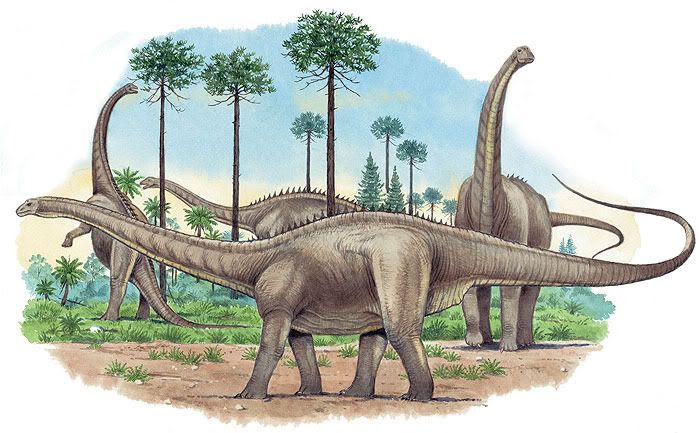Post by dinosauria101 on Jul 16, 2019 9:36:48 GMT 5
Argentinosaurus huinculensis
Argentinosaurus is a genus of titanosaur sauropod dinosaur first discovered by Guillermo Heredia in Argentina. The generic name refers to the country in which it was discovered. The dinosaur lived on the then-island continent of South America somewhere between 97 and 94 million years ago, during the Late Cretaceous Epoch. Not much of Argentinosaurus has been recovered. The holotype included three anterior dorsal vertebrae, three posterior dorsal vertebrae, first to fifth sacrum vertebrae (only the ventral sector of the vertebral bodies), most of the sacral ribs of the right side, great part of a fragmented dorsal rib, and the right tibia. One vertebra had a length of 1.59 meters (spine to the ventral border) and the tibia was about 155 centimeters (58 inches). Besides these, an incomplete femur (MLP-DP 46-VIII-21-3) is assigned to Argentinosaurus; this incomplete femur shaft is about 1.18 meters. The proportions of these bones and comparisons with other sauropod relatives allow paleontologists to estimate the size of the animal. An early reconstruction by Gregory S. Paul estimated Argentinosaurus at between 30–35 metres (98–115 ft) in length and with a weight of up to 80–100 tonnes (88–110 short tons). Other estimates have compared the fragmentary material to relatively complete titanosaurs to help estimate the size of Argentinosaurus. In 2006 Carpenter used the more complete Saltasaurus as a guide and estimated Argentinosaurus at 30 metres (98 ft) in length.[5] An unpublished estimate used published reconstructions of Saltasaurus, Opisthocoelicaudia, and Rapetosaurus as guides and gave shorter length estimates of between 22–26 metres (72–85 ft). Weight estimates are less common, but Mazzetta et al. (2004) provide a range of 60–88 tonnes (66–97 short tons), and consider 73 tonnes (80 short tons) to be the most likely, making it the heaviest sauropod known from good material.

Apatosaurus ajax
Apatosaurus (meaning "deceptive lizard") is a genus of herbivorous sauropod dinosaur that lived in North America during the Late Jurassic period. Othniel Charles Marsh described and named the first-known species, A. ajax, in 1877, and a second species, A. louisae, was discovered and named by William H. Holland in 1916. Apatosaurus lived about 152 to 151 million years ago (mya), during the late Kimmeridgian to early Tithonian age, and are now known from fossils in the Morrison Formation of modern-day Colorado, Oklahoma, New Mexico, Wyoming, and Utah in the United States. Apatosaurus ajax would have averaged from 22 to over 30 meters (72 to over 100 feet) in length, and would have had an average weight ranging from 20 to over 95 tons, based on larger specimens.

Credit to Wikipedia
Argentinosaurus is a genus of titanosaur sauropod dinosaur first discovered by Guillermo Heredia in Argentina. The generic name refers to the country in which it was discovered. The dinosaur lived on the then-island continent of South America somewhere between 97 and 94 million years ago, during the Late Cretaceous Epoch. Not much of Argentinosaurus has been recovered. The holotype included three anterior dorsal vertebrae, three posterior dorsal vertebrae, first to fifth sacrum vertebrae (only the ventral sector of the vertebral bodies), most of the sacral ribs of the right side, great part of a fragmented dorsal rib, and the right tibia. One vertebra had a length of 1.59 meters (spine to the ventral border) and the tibia was about 155 centimeters (58 inches). Besides these, an incomplete femur (MLP-DP 46-VIII-21-3) is assigned to Argentinosaurus; this incomplete femur shaft is about 1.18 meters. The proportions of these bones and comparisons with other sauropod relatives allow paleontologists to estimate the size of the animal. An early reconstruction by Gregory S. Paul estimated Argentinosaurus at between 30–35 metres (98–115 ft) in length and with a weight of up to 80–100 tonnes (88–110 short tons). Other estimates have compared the fragmentary material to relatively complete titanosaurs to help estimate the size of Argentinosaurus. In 2006 Carpenter used the more complete Saltasaurus as a guide and estimated Argentinosaurus at 30 metres (98 ft) in length.[5] An unpublished estimate used published reconstructions of Saltasaurus, Opisthocoelicaudia, and Rapetosaurus as guides and gave shorter length estimates of between 22–26 metres (72–85 ft). Weight estimates are less common, but Mazzetta et al. (2004) provide a range of 60–88 tonnes (66–97 short tons), and consider 73 tonnes (80 short tons) to be the most likely, making it the heaviest sauropod known from good material.
Apatosaurus ajax
Apatosaurus (meaning "deceptive lizard") is a genus of herbivorous sauropod dinosaur that lived in North America during the Late Jurassic period. Othniel Charles Marsh described and named the first-known species, A. ajax, in 1877, and a second species, A. louisae, was discovered and named by William H. Holland in 1916. Apatosaurus lived about 152 to 151 million years ago (mya), during the late Kimmeridgian to early Tithonian age, and are now known from fossils in the Morrison Formation of modern-day Colorado, Oklahoma, New Mexico, Wyoming, and Utah in the United States. Apatosaurus ajax would have averaged from 22 to over 30 meters (72 to over 100 feet) in length, and would have had an average weight ranging from 20 to over 95 tons, based on larger specimens.

Credit to Wikipedia






